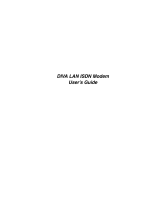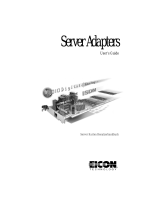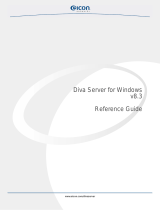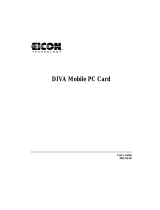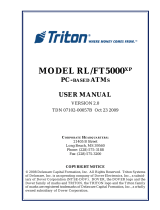Page is loading ...

www.eicon.com
Eicon 1530 WAN Router
User’s Guide

2
Second Edition (December 2001) 206-391-02
Eicon, Eicon Networks, and Diva are either registered trademarks or trademarks of Eicon
Networks Corporation.
Microsoft, Windows, and Windows NT are either registered trademarks or trademarks of
Microsoft Corporation in the United States and/or other countries.
Adobe and Acrobat are either registered trademarks or trademarks of Adobe Systems
Incorporated in the United States and/or other countries.
Apple and Macintosh are trademarks of Apple Computer, Inc. in the United States and/or other
countries.
IBM is a registered trademark of IBM Corporation in the United States and/or other countries.
All other brand and product names are trademarks or registered trademarks of their respective
owners.
Changes are periodically made to the information herein; these changes will be incorporated
into new editions of the publication. Eicon Networks may make improvements and/or changes
in the products and/or programs described in this publication at any time.
Eicon Networks Corporation may use or distribute whatever information you supply in any way
it believes appropriate without incurring any obligations to you.
Eicon Networks Corporation is a business unit of i-data international a-s.
Copyright © 2001 Eicon Networks Corporation. All rights reserved, including those to
reproduce this publication or parts thereof in any form without permission in writing from
Eicon Networks Corporation.

3
Contents
Introduction ....................................................................................................6
Overview ................................................................................................................................... 7
Package Contents..................................................................................................................... 8
Specifications............................................................................................................................ 9
Setup .............................................................................................................11
System Requirements.............................................................................................................12
Connect the Cables ................................................................................................................ 13
Verify Computer TCP/IP Settings............................................................................................ 14
Log in to the Eicon 1530 .........................................................................................................15
Modify VHSI Settings .............................................................................................................. 17
Create a Profile ....................................................................................................................... 19
Modify LAN Settings (if required) ............................................................................................ 21
Reset the Device..................................................................................................................... 22
Test WAN Access.................................................................................................................... 23
Adjusting LAN Settings (if required)........................................................................................ 24
Changing TCP/IP Settings to DHCP....................................................................................... 25
Technical Support ................................................................................................................... 27
Using your Eicon 1530................................................................................. 28
Ports and Indicator Lights ....................................................................................................... 29
Resetting the Device via the Reset Button ............................................................................. 30
Accessing the Configuration Menu ......................................................................................... 31
Upgrading Firmware via a Web Browser ................................................................................ 35
Saving and Resetting Configuration Settings ......................................................................... 36
Changing the VHSI Port Protocol ........................................................................................... 37
Creating and Editing Profiles .................................................................................................. 39
Security.........................................................................................................41
Overview ................................................................................................................................. 42
Security Features Summary ................................................................................................... 43
System Password ................................................................................................................... 44
Automatic Log Out .................................................................................................................. 45
Network Address Translation (NAT) ........................................................................................ 46
Remote Management ............................................................................................................. 49
Authentication (PPP only) .......................................................................................................51
Manual Dialing ........................................................................................................................ 52
Custom Security Features using IP Filters.............................................................................. 53

Contents 4
Web Interface Settings Glossary ................................................................61
System Menu .......................................................................................................................... 62
Connection Menu.................................................................................................................... 63
Connection Menu > Connection Group (when protocol is set to PPP) ................................... 64
Connection Menu > Connection Group (when protocol is set to X.25) ................................... 65
Connection Menu > Connection Group (when protocol is set to Frame Relay) ...................... 67
Connection Menu > IP Group ................................................................................................. 68
Connection Menu > RIP Group............................................................................................... 69
Connection Menu > Authentication Group (when protocol is set to PPP)............................... 70
Connection Menu > DNS Group ............................................................................................. 71
IP Menu................................................................................................................................... 72
Routes Menu (IP Tree)............................................................................................................ 73
Filters Menu (IP Tree) ............................................................................................................. 74
NAT Mapping Menu (IP Tree).................................................................................................. 75
Time Client Menu (IP Tree) ..................................................................................................... 76
SNMP Menu (IP Tree).............................................................................................................77
DHCP Menu (IP Tree) .............................................................................................................78
LAN Menu ............................................................................................................................... 80
LAN Menu > RIP Group.......................................................................................................... 81
LAN Menu > DNS Parameters Group..................................................................................... 82
VHSI Port Menu ...................................................................................................................... 83
VHSI Port Menu > Delays Group ............................................................................................ 85
Protocol Menu (VHSI Tree) (when protocol is set to X.25) .................................................... 86
Protocol Menu (VHSI Tree) > Virtual Circuits Group (when protocol is set to X.25) ............... 88
Protocol Menu (VHSI Tree) > Timers Group (when protocol is set to X.25) ........................... 89
HDLC Menu (VHSI/Protocol Tree) (when protocol is set to X.25)........................................... 90
HDLC Menu (VHSI/Protocol Tree) > X32 Services Group (when protocol is set to X.25) ...... 92
HDLC Menu (VHSI/Protocol Tree) > Timers Group (when protocol is set to X.25)................. 93
Protocol Menu (VHSI Tree) (when protocol is set to Frame Relay) ........................................ 94
Protocol Menu (VHSI Tree) Dynamic DLCI Group (when protocol is set to Frame Relay) ..... 96
Static DLCI Menu (VHSI/Protocol Tree) (when protocol is set to Frame Relay) ..................... 97
Dialer Menu (VHSI Tree).........................................................................................................98
Selecting an Interface Cable .......................................................................99
Interface Cables available from Eicon Networks................................................................... 100
Interface Cable Specifications............................................................................................... 101
The V.24 Interface................................................................................................................. 102
The V.35 Interface................................................................................................................. 104

5
Command Line Interface ........................................................................... 106
Overview ............................................................................................................................... 107
General Commands.............................................................................................................. 108
Time and Date Commands ................................................................................................... 110
Log Commands..................................................................................................................... 111
Mail Trace Commands .......................................................................................................... 112
Profile Commands ................................................................................................................113
Context Commands .............................................................................................................. 114
DHCP Commands ................................................................................................................ 115
Direct Commands .................................................................................................................118
HAYES Commands............................................................................................................... 119
V25BIS Commands .............................................................................................................. 122
DNS DOMAIN Commands.................................................................................................... 124
ETHERNET Commands ....................................................................................................... 125
Frame Relay Commands ...................................................................................................... 126
HDLC Commands................................................................................................................. 129
IP Route Commands............................................................................................................. 132
UDP and TCP Commands.................................................................................................... 133
IP Filter Commands ..............................................................................................................134
NAT Commands....................................................................................................................137
IP Commands ....................................................................................................................... 138
VHSI Port Configuration Commands .................................................................................... 140
PPP Commands ................................................................................................................... 143
RIP Commands..................................................................................................................... 146
SNMP Commands ................................................................................................................ 148
TFTP Commands.................................................................................................................. 149
Time Protocol Commands .................................................................................................... 150
X.25 Commands ...................................................................................................................151
Regulatory and Warranty Information......................................................157
Index............................................................................................................161

6
Introduction
Overview ...................................................................................................................... 7
Package Contents ........................................................................................................ 8
Specifications ............................................................................................................... 9

Introduction 7
Overview
Thank you for purchasing the Eicon 1530 WAN Router.
The Eicon 1530 is an intelligent Ethernet-to-WAN router that supports PPP, Frame Relay, and
X.25 protocols. The Eicon 1530’s VHSI port can transfer data at speeds from 2400 bps to
2048 kbps, depending on the interface used.
Hardware Features
The Eicon 1530 features a 36-pin VHSI (Very High Speed Interface) port, that supports both
V.24 and V.35 interfaces. The intelligent controller on the Eicon 1530 detects the type of cable
connected to the VHSI port and the actual board configuration, and will then select the
matching interface.
The Eicon 1530 can be used on a LAN and can also be used as a DHCP server. You can also
connect the Eicon 1530 directly to a single computer (crossover cable required, sold
separately).
Upgradable Firmware
The Eicon 1530’s firmware (a set of software instructions that tells the device how to operate)
is stored in flash memory on the device. This makes it easy to upgrade the firmware when new
versions become available.
Ease of Use
Changing settings is a straight-forward process, as parameters are accessed via a web browser.
You can also make changes using the command line interface, which is accessed using a telnet
application or programs such as HyperTerminal, through the Ethernet connection.
About this Guide
This guide describes how to install and configure the Eicon 1530 on any computer capable of
support an Ethernet card and TCP/IP. The installation instructions compliment those found in
the Quickstart Guide, which is also included with your package. This guide also describes how
to make changes to certain features.
Note: This guide does not describe how to configure the device for any one particular networking situation.
For information on what any particular setting should be, consult your network administrator.
For instructions on setting up communications protocols and using applications that access the
external network, consult the documentation provided with your software.

Introduction 8
Package Contents
Your package should contain the following:
VHSI cables are not included with your Eicon 1530. Cables can be ordered from Eicon
Networks, or you can build your own (see the User’s Guide).
Note: The blue cable is a straight-through Ethernet cable and is used to connect the Eicon 1530 to a
network hub. To connect to a single computer, a crossover cable (sold separately) is required.
About the Eicon 1530 CD-ROM
The Eicon 1530 CD-ROM contains the following:
• User’s Guide in PDF and HTML formats.
• Quickstart in PDF format.
• Release notes in text format.
• Installers for Adobe Acrobat Reader (for reading PDF files) and Microsoft Internet Explorer.
Eicon 1530
Power Adapter Ethernet Cable (Blue)
Quickstart Guide CD-ROM

Introduction 9
Specifications
Hardware Features
• VHSI (Very High Speed Interface) port, supports V.24 and V.35 interfaces
• Ethernet 10BaseT RJ45 port
• AUX port (DB9 V.24 serial interface) (currently unsupported)
• Power jack
• Hard Reset button
• Indicators lights
• Flash memory for convenient firmware upgrade (if available)
VHSI Port (Synchronous)
• 36-pin high-density D-type connector
• Auto-detection of the following interface types:
– V.24 (EIA RS232-C)
–V.35
• Speeds: 2400 bps to 2048 Kbps, depending on interface
• Protocol support: PPP, Frame Relay, X.25, Frame Relay
Indicator Lights
• Power status
• VHSI port status
• AUX port status (currently unused)
• Ethernet connector status (located on the connector itself)
• Ethernet activity (located on the connector itself)
Protocol support
• PPP:
– PPP compression (PPP CCP, PPP LZS-STAC, MPPC, Ascend LZS)
– Security: PAP, CHAP, MS-CHAP
•X.25:
– CCITT/ITU compliance: X.25, X.32, and X.121 (1984)
– Up to eight X.25 virtual circuits (includes PVCs and SVCs)
– PVC and SVC support with inactivity timeouts
– Compression (Eicon Stacker, CISCO, Bay Networks)
•Frame Relay:
– IP over Frame Relay (RFC 2427)
– Maximum of 8 DLCI
– Routing between DLCI
– Congestion management (FECN, BENC)
– Extended LSN
– Automatic LMI detection
– Congestion control (FECN & BECN)
– Frame Relay compression (FRF.9)

Introduction 10
LAN Protocol support
• IP routing (dynamic and static)
• IP Network Address Translation (NAT)
• IP spoofing and packet filtering
• DHCP Server and DHCP Relay Agent
• BOOTP, TFTP, Telnet, ARP, and DNS
Environmental Requirements
• Operating temperature: 0°C to +50°C
• Storage temperature: -20°C to +70°C
• Operating humidity: 0 to 90% (non-condensing)
Power Requirements
• External AC wall mount adapter providing 9-15VDC/1A
• Power consumption: 5 Watts maximum
Warranty
• Five years
Certification
•CE
• FCC Part 15 Class B
• CSA/NRTL (UL)
• Industry Canada
Management Utilities
• Web-based configuration interface
• Command line interface
Packaging Contents
• Eicon 1530 WAN Router
• Straight-through Ethernet cable (blue)
• Power adapter
• QuickStart Guide
• Eicon 1530 CD-ROM (contains documentation)
Note: A VHSI port cable is not included, but can be ordered separately from Eicon Networks.

11
Setup
System Requirements ............................................................................................... 12
Step 1: Connect the Cables ...................................................................................... 13
Step 2: Verify Computer TCP/IP Settings.............................................................. 14
Step 3: Log in to the Eicon 1530 .............................................................................. 15
Step 4: Modify VHSI Settings.................................................................................. 17
Step 5: Create a Profile............................................................................................. 19
Step 6: Modify LAN Settings (if required) ............................................................. 21
Step 7: Reset the Device............................................................................................ 22
Step 8: Test WAN Access .......................................................................................... 23
Adjusting LAN Settings (if required)...................................................................... 24
Changing TCP/IP Settings to DHCP ...................................................................... 25
Technical Support ..................................................................................................... 27

Setup 12
System Requirements
Before you begin, review the system requirements, as outlined below.
If you are connecting the Eicon 1530 directly to a computer, the following is required:
• A 10Base-T Ethernet network interface card, properly installed and configured to use the
TCP/IP protocol. A 100 Mbps Ethernet card can be used if the card supports auto-sensing.
• TCP/IP communications protocol configured to obtain its IP address automatically (DHCP
client), and not configured to use a DNS server.
If you are unsure about these topics, consult the documentation for your operating system or
network adapter for more information.
Web Browser Requirements
The Eicon 1530 is configured via web pages stored on the device itself. To access the web
interface, you must be have Netscape Navigator 4 or Microsoft Internet Explorer 4, or later.
Additionally, your Web browser must be configured to connect to the Internet via a local area
network (LAN) and not through a proxy server.
An installer for Microsoft Internet Explorer is included on the Eicon 1530 CD-ROM for all
Windows operating systems except Windows 3.1. Windows NT 4.0 requires SP3 or later,
available from http://www.microsoft.com/.

Setup 13
Step 1: Connect the Cables
Leave your computer on when connecting the cables.
1.
Connect the power adapter. The Power indicator light should turn green.
Note: For more information on indicator lights, see Ports and Indicator Lights on page 29.
2.
Connect your VHSI Cable.
Connect the appropriate end of the cable to the VHSI port of the Eicon 1530, and connect
the other end to your modem or leased line connector.
Note: VHSI cables are not included with your Eicon 1530. Cables can be ordered from Eicon Networks,
or you can build your own (see the User’s Guide).
3.
Connect the Ethernet cable.
The green light at the top left corner of the Ethernet port should turn on when the cable is
connected properly.
What’s Next?
See Step 2: Verify Computer TCP/IP Settings on page 14.
LAN Plug one end of the included blue Ethernet cable into your network hub, then
plug the other end into the Eicon 1530’s Ethernet port.
Single
Computer
Note: To connect the Eicon 1530 to a single computer, a crossover cable (sold
separately) is required.
Plug one end of your crossover cable into the Ethernet port on your computer,
then plug the other end into the Eicon 1530’s Ethernet port.
Back of device
VHSI Port Ethernet Port
Power
Front of device
VHSI
cable
Blue
Ethernet
cable
(straight-
through)
Power
adapter
To modem or
leased line
Ethernet Hub
VHSI
Light
Ethernet
Lights
Power
Light

Setup 14
Step 2: Verify Computer TCP/IP Settings
The Eicon 1530 settings are changed via a series of web pages that reside on the Eicon 1530
itself. However, to access these pages, your TCP/IP settings must be configured appropriately,
as described below.
IP Address Recommendations
• Set your Ethernet card to acquire its IP address dynamically if:
– You are connecting the Eicon 1530 to a single computer.
– You are installing on a LAN and wish to use the Eicon 1530 as your DHCP server.
The Eicon 1530, which has a built-in DHCP server, will assign an IP address to your
computer’s Ethernet card. Most network cards are configured this way by default.
• Set the IP address of your Ethernet card to the address 192.168.1.2 and subnet mask to
255.255.255.0, with the default gateway left blank, if:
– Your LAN already has an existing DHCP server.
– Your LAN uses static IP addressing.
By changing your IP address and subnet mask to these values, you are ensuring that your
computer is on the same subnet as the Eicon 1530, whose IP address is 192.168.1.1 by default.
Later you will change the Eicon 1530’s IP address to one more appropriate for your LAN.
Note: For information on changing TCP/IP settings, see Changing TCP/IP Settings to DHCP, or consult
the documentation included with your operating system.
LAN Setup Notes
• Due to the wide range of networking equipment and topologies that are in use worldwide,
your configuration needs may fall outside the instructions presented here. Contact your
network administrator or other support person to help you with the installation.
• The Eicon 1530’s internal DHCP server is enabled by default. However, if the Eicon 1530
detects the presence of the an existing DHCP server, the Eicon 1530 will disable its own DHCP
server automatically. To re-enable the Eicon 1530 DHCP server, remove the other server from
the LAN and press the reset button on the Eicon 1530.
Restarting your computer
For some operating systems, you must restart your computer after changing TCP/IP settings. If
you are using the Eicon 1530 as a DHCP server on your LAN, or if you have connected the
Eicon 1530 to a single computer, restarting will force your computer to acquire a new IP
address.
If you are using Windows, you can do the following:
• Windows 95/98/Me: Click ‘Start’, ‘Run’, type ‘winipcfg’, and click ‘OK’. Click ‘Renew All’.
• Windows NT/2000/XP: Launch a command prompt, type ‘ipconfig /release’ and press Enter,
then ‘ipconfig /renew’ and press Enter.
What’s Next?
See Step 3: Log in to the Eicon 1530 on page 15.

Setup 15
Step 3: Log in to the Eicon 1530
Whenever you wish to change settings on the Eicon 1530, you must first log in, as shown below.
1.
Launch your web browser and click ‘File’, ‘Open’.
2.
Enter 192.168.1.1 as the web page to open.
3.
Click ‘OK’. You should see the ‘Log in’ page.
Note: If you do not see the ‘Log in’ page, see Troubleshooting on the following page.
4.
Click the ‘Log in’ button.
Note: By default there is no password.
5.
The main menu should appear, as shown below.
What’s Next?
See Step 4: Modify VHSI Settings on page 17.

Setup 16
Troubleshooting
If you cannot access the ‘Log in’ page:
• Verify that the Ethernet cable is connected properly. The green light at the top left of the
Ethernet port should be on (see Ports and Indicator Lights on page 29 for more information).
• Verify that your computer’s TCP/IP settings are configured according to your situation. As
the Eicon 1530’s default IP address is 192.168.1.1, you will not be able to access the web
pages unless your computer is on the same subnet (assigned an IP address that starts with
192.168.1 and is using the same subnet mask).
• Verify that your web browser is configured to use the LAN and not a dial-up connection, and
that your browser is not set to use a proxy server. See Adjusting Browser Settings (below)
for instructions on how to do this.
If you cannot access the ‘Log in’ page over a LAN:
• Verify that your computer is on the same physical segment as the Eicon 1530.
• Verify that the Eicon 1530 is the only device on your LAN using the address 192.168.1.1. To
see if this is the case, remove the Eicon 1530 from the LAN, then PING the address
192.168.1.1. If you receive a reply, a device on the LAN already has this address. In this case,
the best solution is to connect the Eicon 1530 to a single computer as described below.
• In general, if you cannot access the ‘Log in’ page, connect the Eicon 1530 to a single computer
for configuration purposes. Later on you can reconnect the Eicon 1530 to the LAN. Note that
a crossover cable (sold separately) is required; the blue cable included with your package will
not work when connecting directly to a single computer.
Adjusting Browser Settings
If you are not able to access the configuration pages, verify your browser settings as described
below. Note that the steps may vary slightly depending on the browser version used.
• Internet Explorer version 5 or later:
– From the ‘Tools’ menu, select ‘Internet Options’, click the ‘Connections’ tab, then click
‘Setup’.
– Select the option ‘I want to set up my Internet connection manually’, then click ‘Next’.
– Select ‘I want to connect through a local area network’, then click ‘Next’.
– Clear all proxy options, then click ‘Next’.
– Clear the option ‘Connect to the Internet immediately’, then click ‘Finish’.
• Internet Explorer previous to version 5:
– From the ‘View’ menu, select ‘Internet Options’, then click the ‘Connection’ tab.
– Verify that ‘Connect to the internet using a local area network’ is enabled.
– Verify that the ‘Proxy Server’ option is disabled.
• Netscape Navigator (do one of the following):
– Under Options, click ‘Network Preferences’, then ‘Proxies’. Verify that the ‘No Proxies’
option is selected.
– Under the ‘Edit’ menu, click ‘Preferences’, ‘Advanced’, then ‘Proxies’. Verify that the
‘Direct Connection to the Internet’ is enabled.
Once finished making changes, click ‘OK’, then retry accessing the web configuration pages.

Setup 17
Step 4: Modify VHSI Settings
Once you have logged into the Eicon 1530 web interface, the first setting you should verify is
the choice of protocol for the VHSI port (set to ‘X.25’ by default). The protocol should be
selected first because all profile settings (which define particular connections) are deleted when
the protocol is changed.
About the Web Interface
The Eicon 1530 settings are changed via web pages that reside on the Eicon 1530 itself.
• When making changes using the web interface, make sure to click the ‘Save’ button on
each page. The ‘Save’ button is located at the bottom right of each web page. If you move to
another page without saving, your changes will not be saved to the device.
Once saved, the new settings will not take effect until you reset the device. It is not necessary
to do a reset until you have completed all the steps in this quickstart.
• The ‘Reset Form’ button, located at the bottom left of each page, reverts all settings in the
current page back to the original values when the page was opened.
• Clicking a setting name displays context-sensitive help.
• Once you have finished making changes to all settings, you must click the ‘Reset’ button,
located at the top of the browser window, for the settings to take effect.
‘Save’
button
‘Reset
form’
button

Setup 18
Choosing a VHSI Protocol
1.
From the Link List (the menu at the left of the screen), click on the small ‘+’ next to ‘VHSI
Port’ to expand the VHSI Port group, then click the ‘Protocol’ link.
2.
From the ‘Protocol’ drop-down menu, select a protocol.
3.
Click the ‘Save’ button, located at the bottom right of the web page, when finished.
Note: If you do not click ‘Save’, the changes will be lost when you move to another page.
Modifying Other VHSI Settings
After choosing a protocol, make changes to your VHSI settings, if required. The settings
presented will depend on the protocol chosen.
Note: You can bring up context-sensitive help for each setting by clicking on the setting name. Also, when
making changes, ensure that the new settings are consistent with those of your network provider.
• If the protocol is set to X.25 or Frame Relay:
– Verify all settings as presented on the Protocol page (this should be the current page) and
click ‘Save’.
– If required to make changes to HDLC or Static DLCI settings, click the ‘HDLC’ (for X.25)
or ‘Static DLCI’ (for Frame Relay) link (located at the top of the Protocol page), make any
required changes, then click ‘Save’.
• If the VHSI port is connected to a dial-up line, click ‘Dialer’ in the Link List. Make any
required changes, then click ‘Save’.
• Click ‘VHSI Port’ in the Link List. Make any required changes, then click ‘Save’.
What’s Next?
See Step 5: Create a Profile on page 19.
‘Protocol’
link
‘Protocol’
drop-down
menu

Setup 19
Step 5: Create a Profile
Settings for particular connections are contained in profiles on the Eicon 1530.
Note: When you change protocols for the VHSI interface, all profile information is lost. To avoid having to
re-enter configuration information, choose the protocol first, as described at the beginning in Step 4: Modify
VHSI Settings on page 17.
Creating a Profile
1.
From the Link List, click the ‘Connection’ link. The ‘Connection Profiles’ page appears.
2.
To add a profile, enter the name in the ‘Name’ field, then click the ‘Done’ button.
Note: With X.25 or Frame Relay, you can create up to eight profiles. For PPP, you can create only one
profile.
3.
The web page for your new profile will be displayed.
4.
To edit the profile, make sure it is selected and click ‘Edit”.
5.
Make the required changes to the profile. Be sure to scroll down and inspect all parameters.
In particular:
• If you are using X.25, make sure to enter the remote DTE address and remote IP address.
• If you are using Frame Relay, make sure the local DLCI number is the same as the remote
DLCI.
• If you are using PPP, make sure to enter the IP information at the bottom of the page.
6.
Click the ‘Save’ button (located at the bottom right of the page) when finished.
‘Name’
field

Setup 20
Switching Between Profiles
When you have more than one profile, selecting the associated radio button allows you to select
which profile to edit.
Deleting Profiles
To delete a profile:
1.
Select the profile and click ‘Delete’.
To delete all profiles, click the ‘Delete All’ button.
What’s Next?
See Step 6: Modify LAN Settings (if required) on page 21.
1. Select
Profile
2. Click
‘Edit”.
1. Select
profile
2. Click
‘Delete’.
/




